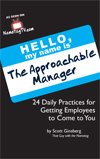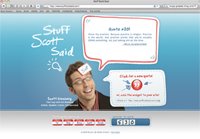 Almost everyone deals with one.
Almost everyone deals with one.
A bully. A tyrant. A toxic person. A pain in the ass.
You know, a jerk.
THE BAD NEWS IS: It’s part of life. It’s part of having a job. It’s part of working with people.
THE GOOD NEWS IS: You have a choice in how you respond to these people.
Today we’re going to explore the most effective attitudes and responses for approaching (and being approached by) jerks.
We’ll identify philosophies and practices you need to interact with your coworkers in healthy ways. Namely, those that DON’T make you want to gouge out your eyes with a letter opener.
Now, before we look at the strategies, let’s examine four big-picture issues…
FIRST: The reality of the jerk.
Accept the fact that you’re not going to change this person’s mind. Nor will you fundamentally alter his personality.
Chronic jerky behavior tends to be deep seeded and therefore, immobile. As such, it’s VERY hard to force people to renovate their habits and attitudes.
What’s worse, a jerk’s behavioral patterns have probably garnered him (some form of) success over his career. Otherwise he wouldn’t still be working there. This means the jerk’s incentive to change is about as attractive as relocating his cubicle to the septic tank.
SECOND: The reality of the context.
Also keep in mind the stratospheric ridiculousness of the typical corporate mentality: As long as the jerk meets the bottom line, he’s likely to continue behaving in the same way without anyone reprimanding him.
Sad but true. So again, remember that there’s little incentive to change.
THIRD: The reality of you.
Jerks cause people stress. Period. Now, I don’t have any fancy statistics to back this statement up; but I triple dog dare you to argue against it. And here’s the problem: With prolonged exposure, the chronic hostility induced by jerks CAN negatively affect your health.
As Lillian Glass wrote in Toxic People, “We’re so used to having toxic comments hurled at us by others that we begin to feel comfortable with them.”
The danger is, even if it’s only a few negative comments by your boss here and there, it still adds up. And contaminated environments will eventually hurt you directly.
Especially if you become SO frustrated with a coworker that you decide to spend your lunch hour smashing your head into the copy machine until the toner cartridge starts printing in red. Not exactly good for your health.
FOURTH: The reality of the solution.
Gary Namie said it best in Bullies at Work: “When dealing with difficult people, most normal adult communication techniques don’t work. And that will drive you up the wall.”
This means two things: (1) You’ve got to try new approaches, and (2) None of these approaches will work unless YOU are calm and emotional unreactive.
– – –
OK! Now that you’re aware of these four jerky realities, lets dig into some strategies for maintaining your approachability, even when dealing with people who drive you up the wall.
1. Change your reponse. You don’t need to change your situation, your environment or the people in it. In fact, you can’t. There are only three things in the world you CAN control: (1) Your thoughts, (2) Your choices, and (3) Your responses.
Notice I said “responses,” not reactions. HUGE difference. Reactions are unconscious reflexes; responses are conscious decisions.
So, no matter how hostile, rude or annoying some people are, you need to be strong enough to F-R-E-E-Z-E. To hold that moment in a loving space and engage in self-exploration via healthy internal dialogue.
This will help you dilute the toxicity of the effects of these people early on. And the cool part is, once you identify and understand the root of someone’s unapproachable behavior, you exponentially increase your ability to handle the person effectively.
Take some time out to assess what’s happening (and why) by asking yourself questions like:
o Could I possibly remind this individual of someone in their past who gave them a hard time?
o Did something change in this person’s personal life – perhaps a financial situation – making her more secretive and unapproachable?
o Did something change in this person’s workload or status making her more cold and rigid?
o How is it possible that this person could think or behave in this way, and under what circumstances would it make perfect sense to do so?
o If this person “accidentally” got run over by the UPS truck, would people suspect me?
o In what ways have my needs begun to clash with hers?
o Is this person threatened by me being rewarded at work and is shutting me out of the loop?
o Was there an incident between us that left bad feelings?
o Were there clues early on that this individual was going to put up barriers toward me or others?
o What are the verbal cues this person is offering that indicate what they value?
o What is it in me that might be causing this situation?
o Is it possible this person is a cyborg?
2. Understand the source. Let’s say your coworker, Karen, is a huge pain in the butt to work with. She saps you of your effectiveness and energy. Her behavior impairs your performance and creates an atmosphere of paranoia.
She shows no regard for your opinions. She displaces her fears on you. She’s interpersonally exploitative. And to compound the awfulness of the situation, she’s oblivious to those around her and unaware of the impact she’s having on you.
Yikes. Try this:
o Go to the source. Instead of trying to fight back, seek to establish an environment in which the abuse doesn’t occur. For example, let’s say someone is spreading office rumors about you. The single greatest strategy to deflect such nastiness is to live your life in a way that makes those rumors hard to swallow.
o Reduce exposure. As Mr. Miyagi suggested in The Karate Kid, “The best way to block a punch is to not be there.” So, consider the simple strategy of reducing your exposure to certain people.
And as Scott Adams explained in The Dilbert Principle, “You can’t win irrational people over to your side by your superior reasoning abilities. Trying to win an argument with an irrational person is like trying to teach a cat to snorkel by providing written instructions. You best strategy is to reduce the time you spend in that sort of situation.”
One strategy for doing so is to hold meetings in which the attendees (jerk included) are required to stand, not sit. According to The No Asshole Rule, requiring people to stand reduces the average meeting time by over 30%.
3. Use inner resources. OK. You’ve changed your immediate response. You’ve considered the source. Lastly, keep these actionable strategies at your disposal whenever you’re faced with consistent jerky behavior.
o Hold your gaze. Eye contact is an indicator of confidence. Don’t look away or you’ll appear intimidated. And, this will give the jerk the impression that his tactics are working and continue to fuel his fire. At the same time, don’t challenge the person to a staring duel. That only works in Westerns. Find the right balance.
o Increase your listenability. Because jerks aren’t great listeners, you need to try extra hard to make yourself more listenable. Check out this handy guide I wrote on (not) how to “get people to listen to you,” but rather, how to become a more listenable person.
o Breathe. When you own your breath, nobody can steal your peace. I learned this from taking yoga for the past two years, and it’s been an invaluable skill. Sure, it sounds cheesy and new age, but that doesn’t mean it’s ineffective. Just remember: The more disturbing people’s actions are, the more you need to coolly respond, instead of reacting. Cultivating a relationship with your breath will help you do that.
REMEMBER: Jerks are part of life. They’re part of having a job. They’re part of working with people.
Fortunately, you have a choice in how you deal with these people: You can either react, which is an unconscious reflex; or respond, which is a conscious decision.
Or, when all else fails, you can always resort to passive aggression, hostile confrontation or ice pick-related murder.
And if that’s the case, you don’t know me.
LET ME ASK YA THIS…
What’s your secret for approaching jerks?
LET ME SUGGEST THIS…
For the list called, “26 Rapid-Fire Strategies for becoming the Most Approachable Person in Your Organization,” send an email to me, and I’ll send you the list for free!
* * * *
Scott Ginsberg
That Guy with the Nametag
Author, Speaker, Coach, Entrepreneur
[email protected]
 If they can’t come UP to you; how will they ever get BEHIND you?
If they can’t come UP to you; how will they ever get BEHIND you?
Buy Scott’s new book and learn daily practices for becoming a more approachable manager!
Pick up your copy (or a case!) right here.
 1. Foster customer activity. Especially during long wait times. Giving the customer something to do that enfolds him in the effort and tempers impatience. For example, at Six Flags, they play non-stop cartoons while you wait in 45-minute roller coaster lines. At the Vegas airport, they loop entertaining PSA’s about airport safety starring famous performers like Rita Rudner, Blue Man Group and CarrotTop. What activity could you involve your customers in?
1. Foster customer activity. Especially during long wait times. Giving the customer something to do that enfolds him in the effort and tempers impatience. For example, at Six Flags, they play non-stop cartoons while you wait in 45-minute roller coaster lines. At the Vegas airport, they loop entertaining PSA’s about airport safety starring famous performers like Rita Rudner, Blue Man Group and CarrotTop. What activity could you involve your customers in? The world’s FIRST two-in-one, flip-flop book!
The world’s FIRST two-in-one, flip-flop book!
 1. Build up a critical mass of interest. Now that you’ve attracted people’s attention, you’ve got to KEEP their attention by being interesting. I won’t go into all the details here, but there IS a
1. Build up a critical mass of interest. Now that you’ve attracted people’s attention, you’ve got to KEEP their attention by being interesting. I won’t go into all the details here, but there IS a 
 How you spend your day – literally, hour by hour – will determine how much money you make, how happy you are, how healthy you are and how successful you become.
How you spend your day – literally, hour by hour – will determine how much money you make, how happy you are, how healthy you are and how successful you become.
 1. Action isn’t just eloquence, it’s credibility. And it’s rare. So if you make it your practice to actually execute your ideas quickly, you’ll be ahead of 90% of the world. What have you taken action on today?
1. Action isn’t just eloquence, it’s credibility. And it’s rare. So if you make it your practice to actually execute your ideas quickly, you’ll be ahead of 90% of the world. What have you taken action on today? PICTURE THIS: Somebody just finishes interacting with you. Phone, email, in person, Twitter, whatever. And this person could be a customer, coworker, colleague, manager or employee.
PICTURE THIS: Somebody just finishes interacting with you. Phone, email, in person, Twitter, whatever. And this person could be a customer, coworker, colleague, manager or employee.  The world’s FIRST two-in-one, flip-flop book!
The world’s FIRST two-in-one, flip-flop book! Almost everyone deals with one.
Almost everyone deals with one.
 Congratulations! You got the job interview.
Congratulations! You got the job interview. 1. Articulate strategy and ideas in plain language. The less jargon you use, the more engaging you become.
1. Articulate strategy and ideas in plain language. The less jargon you use, the more engaging you become.  Who’s quoting YOU?
Who’s quoting YOU? So much so that, without it:
So much so that, without it: